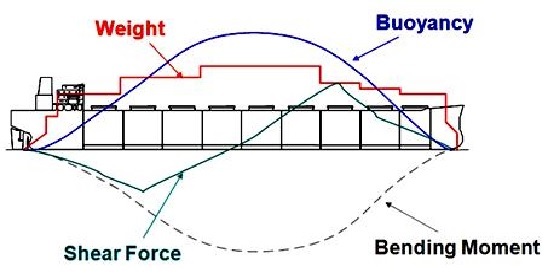When two external parallel forces act in opposite directions on any part of a structure to break it apart or shear it,the forces are known as shearing forces and are measured in tonnes. Shearing stress is, therefore, the stress thatmay break or shear the structure apart.
This force is considered by taking the difference between the buoyancy and the weight force acting onit. According to Archimedes’ principle, for a ship to float the weight force must be balanced by the buoyancy force. Wherever one of these forces exceeds the other, shearing stresses are likely to occur.
In other words we can explain this as:
When a section such as a beam is carrying a load there is a tendency for some parts to be pushed upwards and for other parts to move downwards, this tendency is termed shearing.
The shear force at a point or station is the vertical force at that point. The shear force at a station may also be defined as being the total load on either the left hand side or the right hand side of the station: load being defined as the difference between the downward and upward forces.
Most likely areas for shearing stresses are at about 25% of the ship’s length from stem or stern, particularly at the transverse watertight divisions at this length. For bulk carriers, it has been found that the highest shearing stresses occur at the boundary of the accommodation and the last cargo hold.Shearing Stress is calculated by the formula.
Shearing Stress is calculated by the formula :


how can I know the shearing force limit for my ship?
state some problem and solve it please